
Grant's Tomb, officially the General Grant National Memorial, is the final resting place of Ulysses S. Grant, the 18th president of the United States, and of his wife Julia. It is a classical domed mausoleum in the Morningside Heights neighborhood of Upper Manhattan in New York City, New York, United States. The structure is in the middle of Riverside Drive at 122nd Street, adjacent to Riverside Park. In addition to being a national memorial since 1958, Grant's Tomb is listed on the National Register of Historic Places, and its facade and interior are New York City designated landmarks.

The Alexander Hamilton U.S. Custom House is a government building, museum, and former custom house at 1 Bowling Green, near the southern end of Manhattan in New York City, New York, United States. Designed by Cass Gilbert in the Beaux-Arts style, it was erected from 1902 to 1907 by the government of the United States as a headquarters for the Port of New York's duty collection operations. The building contains the George Gustav Heye Center museum, the United States Bankruptcy Court for the Southern District of New York, and the New York regional offices of the National Archives. The facade and part of the interior are New York City designated landmarks, and the building is listed on both the New York State Register of Historic Places and the National Register of Historic Places (NRHP) as a National Historic Landmark. It is also a contributing property to the Wall Street Historic District, listed on the NRHP.

Riverside Drive is a scenic north–south avenue in the New York City borough of Manhattan. The road runs on the west side of Upper Manhattan, generally paralleling the Hudson River and Riverside Park between 72nd Street and the vicinity of the George Washington Bridge at 181st Street. North of 96th Street, Riverside Drive is a wide divided boulevard. At several locations, a serpentine service road diverges from the main road, providing access to the residential buildings. The avenue was opened in 1880, and several viaducts were completed over the subsequent decades to connect the various segments of Riverside Drive.

Gracie Mansion is the official residence of the mayor of New York City. Built in 1799, it is located in Carl Schurz Park, at East End Avenue and 88th Street in the Yorkville neighborhood of Manhattan. The Federal-style mansion overlooks Hell Gate channel in the East River and consists of two sections: the original two-story house and an annex built in 1966. The original house is a New York City designated landmark and is listed on the National Register of Historic Places.

The Morgan Library & Museum, formerly the Pierpont Morgan Library, is a museum and research library in the Murray Hill neighborhood of Manhattan in New York City. It is situated at 225 Madison Avenue, between 36th Street to the south and 37th Street to the north. The Morgan Library & Museum is composed of several structures. The main building was designed by Charles McKim of the firm of McKim, Mead and White, with an annex designed by Benjamin Wistar Morris. A 19th-century Italianate brownstone house at 231 Madison Avenue, built by Isaac Newton Phelps, is also part of the grounds. The complex includes three additional structures, including a glass entrance building designed by Renzo Piano and Beyer Blinder Belle. The main building and its interior is a New York City designated landmark and a National Historic Landmark, while the house at 231 Madison Avenue is a designated city landmark.

The Gertrude Rhinelander Waldo House is a French Renaissance Revival mansion at the southeastern corner of Madison Avenue and 72nd Street on the Upper East Side of Manhattan in New York City. Built between 1894 and 1898, it was designed by Alexander Mackintosh of the architectural firm of Kimball & Thompson. The house was commissioned by the heiress Gertrude Rhinelander Waldo, who never moved in. It was converted to a commercial building in the 20th century, becoming the New York City flagship store of the Ralph Lauren accessory and clothing company in the 1980s. The mansion is a New York City designated landmark and on the National Register of Historic Places.

The Otto H. Kahn House is a mansion at 1 East 91st Street, at Fifth Avenue, in the Carnegie Hill section of the Upper East Side of Manhattan in New York City. The four-story mansion was designed by architects J. Armstrong Stenhouse and C. P. H. Gilbert in the neo-Italian Renaissance style. It was completed in 1918 as the town residence of the German-born financier and philanthropist Otto H. Kahn and his family. The Convent of the Sacred Heart, a private school, owns the Kahn House along with the adjacent James A. Burden House, which is internally connected. The mansion is a New York City designated landmark and, along with the Burden House, is listed on the National Register of Historic Places.

Hamilton Grange National Memorial is a historic house museum within St. Nicholas Park in the Hamilton Heights neighborhood of Manhattan in New York City. Operated by the National Park Service (NPS), the structure was the only home ever owned by the U.S. founding father Alexander Hamilton. The house contains exhibits for visitors, as well as various rooms with restored 19th-century interiors. Originally located near present-day 143rd Street, the house was moved in 1889 to 287 Convent Avenue before being relocated again in 2008 to St. Nicholas Park. The structure is a New York City designated landmark and a United States national memorial, and it is listed on the National Register of Historic Places.
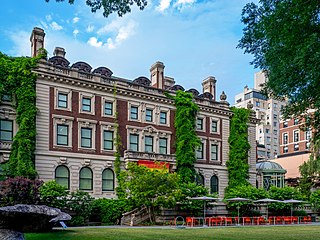
The Andrew Carnegie Mansion is a historic house and a museum building at 2 East 91st Street, on the east side of Fifth Avenue, in the Upper East Side of Manhattan in New York City. The three-and-a-half story, brick and stone mansion was designed by Babb, Cook & Willard in the Georgian Revival style. Completed in 1902 for the industrialist Andrew Carnegie, his wife Louise, and their only child Margaret, it served as the family's residence until 1946. Since 1976, the house has been occupied by the Cooper-Hewitt Museum, part of the Smithsonian Institution. The mansion is internally connected to two townhouses at 9 East 90th Street and 11 East 90th Street, both of which are part of the Cooper-Hewitt.

555 Edgecombe Avenue is an apartment building at the southwest corner of Edgecombe Avenue and 160th Street in the Washington Heights neighborhood of Manhattan in New York City. It was originally known as the Roger Morris Apartments when it was built in 1914–16 – after the retired British Army officer who built the nearby Morris–Jumel Mansion – and was designed by Schwartz & Gross, who specialized in apartment buildings. The building was declared a National Historic Landmark under the name Paul Robeson Residence in 1976, and it became a New York City designated landmark in 1993.
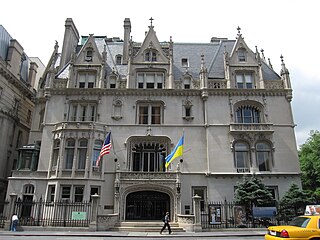
The Harry F. Sinclair House is a mansion at the southeast corner of East 79th Street and Fifth Avenue on the Upper East Side of Manhattan in New York City. The house was built between 1897 and 1899. Over the first half of the 20th century, the house was successively the residence of businessmen Isaac D. Fletcher and Harry F. Sinclair, and then the descendants of Peter Stuyvesant, the last Director of New Netherland. The Ukrainian Institute of America acquired the home in 1955. After the house gradually fell into disrepair, the institute renovated the building in the 1990s. The house was added to the National Register of Historic Places (NRHP) and was named a National Historic Landmark in 1978.

King Manor, also known as the Rufus King House, is a historic house at 150th Street and Jamaica Avenue in Jamaica, Queens, New York City. The two-story house is the main structure in Rufus King Park, an 11.5-acre (4.7 ha) public park that preserves part of the former estate of Rufus King, a U.S. Founding Father. Built c. 1730 and expanded in 1755 and the 1800s, the house is designed with elements of the Federal, Georgian, and Greek Revival styles. The house is designated as a National Historic Landmark, and the house, its interior spaces, and the park are all New York City designated landmarks.
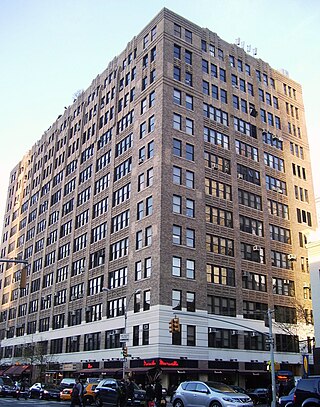
The Film Center Building, also known as 630 Ninth Avenue, is a 13-story office building on the east side of Ninth Avenue between 44th and 45th Streets in the Hell's Kitchen neighborhood of Manhattan in New York City. Built in 1928–1929, the structure has historically catered to businesses involved in film, theater, television and music and audio production. The building was designed in the Art Deco style, with Ely Jacques Kahn as the architect of record. The lobby's interior is a New York City landmark, and the building is on the National Register of Historic Places.

108 Leonard, formerly known as 346 Broadway, the New York Life Insurance Company Building, and the Clock Tower Building, is a residential structure in the Tribeca neighborhood of Manhattan in New York City, United States. Built from 1894 to 1898, the building was constructed for the New York Life Insurance Company. Stephen Decatur Hatch created the original plans while McKim, Mead & White oversaw the building's completion. The building occupies a city block bounded by Broadway to the west, Leonard Street to the north, Lafayette Street to the east, and Catherine Lane to the south. It is a New York City designated landmark and is listed on the National Register of Historic Places.

89th Street is a one-way street running westbound from the East River to Riverside Drive, overlooking the Hudson River, in the New York City borough of Manhattan. The street is interrupted by Central Park. It runs through the Upper West Side, Carnegie Hill and Yorkville neighborhoods.

The James A. Burden House is a mansion at 7 East 91st Street in the Carnegie Hill section of the Upper East Side of Manhattan in New York City. The five-story mansion was designed by architects Warren and Wetmore in the Beaux-Arts style. It was completed in 1905 as the residence of iron entrepreneur James A. Burden Jr. and his wife Florence Sloane Burden. The Convent of the Sacred Heart, a private school, owns the Burden House along with the adjacent Otto H. Kahn House, which is internally connected. The mansion is a New York City designated landmark and, along with the Kahn House, is listed on the National Register of Historic Places.

The Felix M. Warburg House is a mansion at 1109 Fifth Avenue, on the Upper East Side of Manhattan in New York City. The house was built from 1907 to 1908 for the German-American Jewish financier Felix M. Warburg and his family. After Warburg's death in 1937, his widow sold the mansion to a real estate developer. When plans to replace the mansion with luxury apartments fell through, ownership of the house reverted to the Warburgs, who then donated it in 1944 to the Jewish Theological Seminary of America. In 1947, the Seminary opened the Jewish Museum of New York in the mansion. The house was named a New York City designated landmark in 1981 and was added to the National Register of Historic Places in 1982.

The William H. Moore House, also known as the Stokes-Moore Mansion and 4 East 54th Street, is a commercial building in the Midtown Manhattan neighborhood of New York City. It is along 54th Street's southern sidewalk between Madison Avenue and Fifth Avenue. The building was designed by McKim, Mead & White and constructed between 1898 and 1900 as a private residence.
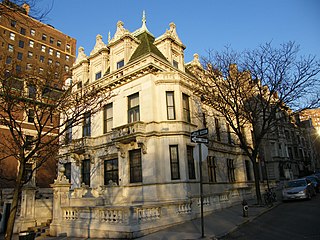
The Schinasi House is a 12,000-square-foot (1,100 m2), 35-room marble mansion located at 351 Riverside Drive on the Upper West Side of Manhattan in New York City. It was built in 1907 for Sephardic Jewish tobacco baron Morris Schinasi. Completed in 1909 at the northeast corner of West 107th Street and Riverside Drive, the three-story, 12,000 square foot mansion was designed in neo-French-Renaissance style by William Tuthill.
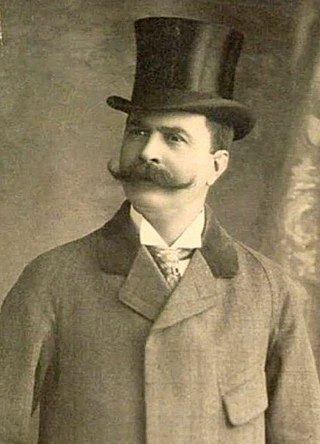
Morris Schinasi was an Ottoman-born wealthy American businessman in the tobacco industry.




























